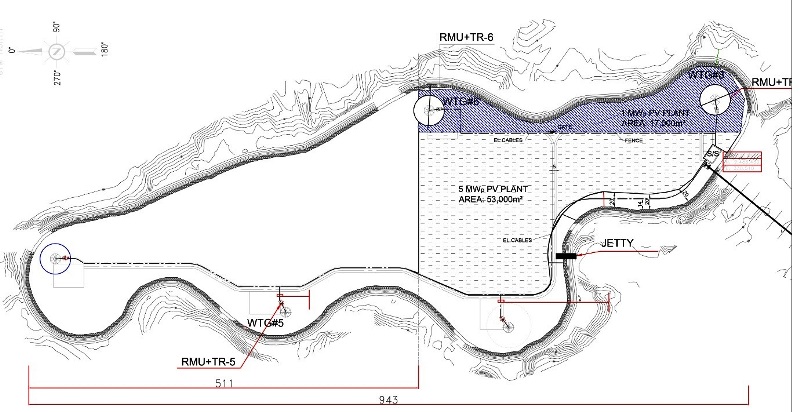Local solar energy production projects: The technicalities and challenges |16 March 2018
The Seychelles government aims to ensure that by the year 2030, 25% of the country’s electricity production will come from renewable, energy resources.
To help achieve this target for increasing methods of renewable energy production, it was announced earlier this week that the Abu Dhabi Fund for Development (ADFD) has allocated Seychelles with a total of 64.2 million United Arab Emirates Dirham (AED) which will fund two projects – a solar farm at Romainville island and the installation of a 33 kilo volts (kV) power grid on Mahé.
To enlighten the public about the technicalities of solar energy production and its challenges, Philippe Morin, chief executive of the Public Utilities Corporation (PUC), shares his knowledge on the subject.

Currently, normal electricity production at the PUC power stations is being done in the conventional way, and that is through burning of fossil fuel. There are a number of serious drawbacks to this particular method of electricity generation.
Firstly, the fossil fuel has to be imported into the country; this is not cheap and the burning process generates noticeable amounts of carbon dioxide (CO2), nitrogen oxides and sulphur oxides which pollute the air and is therefore not eco-friendly.
Every year, 370 million kilowatt hours (kW/hour) of electricity is produced on Mahé to meet the energy demand on the island. A small part of the energy supply is being generated from the two small scale wind farms on Romainville and Ile du Port islands. They produce 7 million kW/hour of electricity annually or 1.9% of the total energy production.
The rated capacity of the solar farm will be 5 megawatts with the ability to generate 7.5 million kW/hour of energy annually. There will later be another project on Romainville, funded by a grant from the government of India, to add one more MW of solar photovoltaic plant. The combined production of the two plants will be around 9 million kilowatt hour annually.
Solar energy production, like wind energy, offers a cleaner, renewable and sustainable alternative that can help the country to become less dependent on imported fossil fuel, thus affording us a good sense of energy security. In the long term, it will also serve as a cheaper source of energy.
A solar panel works by allowing particles of light from the sun called photons to knock out the electrons from the atoms found in the materials of the photovoltaic cells (a process known as photoelectric effect) to produce a flow of electricity. The energy generated is in the form of direct current (DC). An inverter is used to convert the DC energy to alternating current (AC) energy that is later fed into the grid.
At the moment there are some 2-megawatts of aggregate solar photovoltaic capacity in the system coming from small industrial customers (making use of micro sized units of 3-5 kW or larger units up to 50 kW capacity). They are running their own plants tied to the PUC grid where in some cases, the residential customers are able to produce the same amount of electricity that they consume and in the case of the industrial/commercial customers, they are allowed to produce up to half of their electricity consumption.
There are two main challenges for inputting renewable energy into the PUC network:
- Stability of the network: solar energy supply fluctuates widely due to varying weather conditions which can destabilise a power system and in turn lead to a black out. There is therefore a need to have sufficient spinning reserve at the power plant (more capacity than you need). Additionally, batteries will need to be fitted to the system to even out the fluctuations and ensure that energy is still distributed during times of overcast.

- Thermal limits of the network: PUC has a relatively small power system with a network that is made up of small distribution lines and cables. These cables can overheat if too much solar energy is pushed through them. One option is to upgrade / increase the size of the transmission system (cable lines) and currently this is being done by installing 33kV underground cables all the way to the south of Mahé. However, there is no system of adequate capacity to push enough power into the northern part of Mahé at the moment, especially to the large hotels. Likewise, the PUC network cannot accept additional excess power coming from photovoltaic systems in this region.
Funding has however been allocated for the installation of a 33kV underground cable system and a sub-station at Beau Vallon which will enable PUC to give a more reliable supply to private homes and businesses in the north west of Mahé. The new larger capacity cables will incur less waste heat losses as the formation of waste heat is more prevalent in smaller capacity cables. These new developments will take place in conjunction with the expansion of the main power plant at Roche Caiman.
The solar farm is expected to be commissioned early next year while underground network reinforcements for the south of Mahé will take 30 months to complete. Once the tender process has been completed, it should take about 18 months to complete the underground cable installation for the north-west region.
Reference: Livescience
Image sources: PUC




